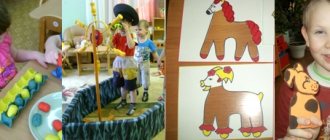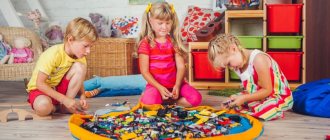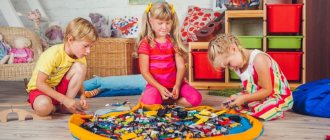Voskobovich's educational games in kindergarten gained popularity at the beginning of the century. Colorful kits with tools and a set of characters for conducting classes were among the first to be mass-produced in a factory version.
The author of the program, Vyacheslav Vladimirovich Voskobovich, made every effort to ensure that teachers understood his idea of the comprehensive development of thinking and creativity in a game with a fairytale edge. And although sets of Voskobovich’s games are sold in almost ready-made form, the author strongly advises introducing your own elements and heroes into the fairy tale, and using foreign objects for visualization. Thus, in the joint creativity of the child and the teacher, the basic skills of logical and creative thinking, reading, and counting will be taught unnoticed and smoothly.
Author
Vyacheslav Vladimirovich Voskobovich, an engineer and physicist from St. Petersburg, was puzzled by the search for educational toys for his own children in the early 90s.
The study of currently existing proposals did not yield anything - the range of domestic teaching material was extremely scarce, and international experience was practically not used.
Acquaintance with the experience of Zaitsev and Nikitins suggested the idea of creating a radically new system of classes, which would be not only useful, but also interesting for children, captivating and developing without forcing them to study. The main idea was to create tools for the comprehensive development of intelligence, logic, talent and personality in a playful way.
Voskobovich’s first games were “Geokont”, “Transparent Square”, “Folds”, “Two-Color Square”. appeared at the very beginning of the 90s. By 1997, the first training manual, “Little Geo, Raven Meter and I, Uncle Slava,” was written, which proposed combining classes with puzzles with a fairy tale twist that immerses the child in the story, giving an additional incentive to action and solving the problem.
In 1999, the author’s program “Fairy Tale Labyrinths of Games” was officially adopted and approved by the Education Committee of St. Petersburg. From now on, Voskobovich presents educational games in preschool educational institutions as an addition to activities that develop intellectual and creative thinking. By the beginning of the century, up to 90% of the city’s kindergartens used the method to one degree or another when organizing work with children.
Currently, the author of the system is the director of Voskobovich's Educational Games. The company and its tutoring center actively cooperate with the Union of Teachers of Russia and conduct training seminars free of charge, including in an online format in accordance with current reality.
Voskobovich's games for preschoolers and their descriptions are offered in sets designed for a certain age and are licensed. Buying an analogue is not encouraged, since the author himself believes that everything is taken into account in the original system. Exact adherence to the author's program, which teachers easily master, gives maximum results, despite the fact that within the framework of the game itself there is always a degree of unpredictable development. The child and the adult become co-creators.
Work program “Fairytale labyrinths of games” by V.V. Voskobovich
- Federal Law on Education in the Russian Federation No. 273 - Federal Law dated December 29, 2012, which entered into force on September 1, 2013;
— “Model regulations on a preschool educational institution” (approved by Decree of the Government of the Russian Federation of September 12, 2008 No. 666);
— “Federal State Educational Standard for Preschool Education” (approved by Order of the Ministry of Education and Science of Russia dated October 17, 2013 No. 1155).
— “Sanitary and epidemiological requirements for the design, content and organization of the operating mode of preschool educational institutions (approved by the Chief State Sanitary Doctor of the Russian Federation on May 29, 2013);
This program regulates the process of development of intellectual and creative abilities in children of the older group.
Purpose of the program:
development of intellectual and creative abilities of preschool children.
Tasks:
promote the child’s development of interest and desire to learn new things;
develop the ability to observe and explore the world around us;
develop imagination, creative thinking (the ability to look at a familiar object with a completely different look, think flexibly and originally);
a harmonious approach to the development of children’s emotionality, imaginative thinking and logic;
provide assistance in the development of mathematical and speech skills;
form initial ideas about the surrounding reality;
promote mental development; develop fine motor skills
Characteristics of children's age characteristics:
A child in his fifth year of life is strikingly different from what he was a year ago. And this is connected not only with improving physical skills and abilities. Age-related characteristics of the development of children aged 4–5 years are characterized, first of all, by the fact that the preschooler has already come to his senses after a recent crisis, and therefore is able to develop more fruitfully in psycho-emotional and creative terms. The baby becomes much wiser, his analytical abilities progress.
GENERAL PICTURE OF AGE
The age of 4–5 years is a time of relative calm: the “wars for power and territory” are over, now the child is calmer, more collected, and obedient. He no longer needs constant care from adults and strives for external independence (although psychological closeness with parents, especially with his mother, will be important for the child throughout at least his entire school life). One of the main distinguishing features of this age is that the child begins to love his family. Not just to say “I love”, because this is how it is customary to express feelings among his immediate circle, but to truly love, understanding the depth of this affection. It is important not to lose this valuable feeling or destroy it through the wrong actions of adults. Mental development continues to have a huge impact on the overall development of a child. At the same time, the characteristics of the age characteristics of the period 4–5 years include the following aspects. Demonstration of independence and initiative to increase one’s own importance in the eyes of parents. This means that the child strives to win respect and appreciation from adults for his actions, and expects praise from them for achievements and good deeds. Without receiving praise, the baby will react with offense. Attention to your health and well-being. The baby can already quite accurately describe his condition and tries to inform his mother or teacher if his health has worsened. Ethical formation. The baby begins to understand the sensations and feelings of other people (not just himself or his peers), learns to empathize with the grief of others, and find a way out of conflict situations when communicating with others. Active socialization. The circle of relationships only within the family is finally broken for the child. The preschooler is increasingly immersed in the world of his peers, increasingly in need not only of their attention, but also of approval, support, and respect. Five-year-old children don’t just play together - they share their impressions of events that happened, purchases, and how their day went. Development of imagination, increasing the role of fairy tales. In the fifth year of life, a child’s creative abilities and imagination actively develop. Children often live in an imaginary world where they play the main role, defeat evil, have strength, wisdom, and seek recognition for their achievements, which are not sufficiently realized in reality. In addition, an ordinary fairy tale now helps a child find a solution to many of his pressing psychological problems, offering a system of images, among which the child chooses the ones that appeal most. He learns to distinguish between good and evil, to be positive. Insatiable curiosity. A preschooler of this age is interested in everything in the world. He asks a wide variety of questions and expects complete answers from adults. If at this moment he does not satisfy the need for such information, he may lose his thirst for knowledge forever! Vulnerability and sensitivity. In the fifth year of life, preschoolers react painfully to comments and punishments. An awkwardly thrown phrase from an adult can give rise to a bunch of complexes in a vulnerable child’s soul that will prevent him from successfully realizing himself in adulthood. Fears and nightmares. The rapid development of fantasy may not always have a positive effect on the child’s emotional state, giving rise to a variety of fears and “bad dreams.” Significant complication of gaming activities. At this age, children’s play becomes much more complex and involves role-playing. Children play store, daughter-mother, hospital, war games. During games, kids develop interaction abilities, showing the whole gamut of emotions: they quarrel, make peace, help, are jealous, and make friends. The differences between people based on gender are becoming much deeper. Now children can differentiate by gender not only clothing or hairstyle, but also, for example, behavior, professions, character traits, demeanor, family ties (girl - sister, daughter, granddaughter, boy - son, brother, grandson). Increased tendency to remember. Although memory is still involuntary, it is in the fifth year that the child tends to remember many different things with an intensity that he will not achieve in subsequent years.
Methodology
Each of Voskobovich's games has clearly defined pedagogical tasks and goals. But during the lesson, not only the child himself, but also the teacher disconnects from it. The kid helps decorate the boat with flags, arranges numbers from the album into the train cars, builds a magical web of strings, while gaining the most useful skills and knowledge for his age, from the development of fine motor skills, if we are talking about a 2-3 year old child, to solving equations. In most cases, the characters and environment are presented in the form of a construction set or mosaic. It will depend on the child himself how they will look in the process - this develops creative thinking, visual memory and a sense of taste.
General objectives of the development program:
- developing interest in the world around us, attention, memory, reducing attention deficit ratio, establishing trusting relationships with adults and playmates;
- developing research interest, creative thinking, and the ability to find non-standard solutions to situations;
- training of creative thinking, logical flexibility;
- psycho-emotional development, increased stress resistance, perseverance;
- practice of developing speaking, reading, and counting skills.
The plots and environments proposed by Voskobovich are only a support for conducting such classes. This is a multifunctional environment with secrets that the teacher himself can unexpectedly discover if he is sincerely interested in the process.
Voskobovich himself saw educational games only as part of the play process - the main activity of a child under the age of 7 years. His idea is to create a fairy-tale space in which the child will have to solve problems, but not imposed by the teacher, but arising as part of that fairy tale. This is exactly the kind of environment “The Violet Forest” should create as a fairy tale, for which the author created his unique characters:
- the wise raven Metro and the brave little Geo;
- invisible All and funny Magnolik;
- Digital Circus and Philemon Cotterfield;
- spider Yuk and the disappearing ice floes;
- Miracle Flower and Bee Zhuzha.
All objects that are offered to the child during the educational process are tied to and are part of this fairy tale. Thus, the tasks posed on Geokont, invented much earlier, began to be solved much more actively when, by the will of the author, it turned into the territory of the spider Yuka. It is more interesting for a child to place not abstract strings in accordance with the diagrams, but a magic web in a flower meadow. The creation process goes smoothly with pleasure from the task being solved - helping a specific character.
A universal sensorimotor environment allows activities to grow with the child. Using the same instrument, sometimes with replacement of its parts, the child learns first to identify colors, then to read and count, and then to solve complex logical algorithms.
The teacher in this story becomes a partner. The development of the plot also depends on it - only the basic elements are included with the tasks, which can be supplemented with available materials, developing both yourself and the child’s creative streak. The only condition for the implementation of the author's program remains a purple background, which stimulates creative thinking and creativity. It also allows you to abandon stereotypes in the display of elements from the first step.
Card index of games by V. Voskobovich
Fatima Yanuzakova
Card index of games by V. Voskobovich
Game "Catch a Butterfly"
Target:
• formation of ideas about sensory standards of color, shape, size;
• training in methods of examining objects, the ability to distinguish their shape, color and size, and perform complex visual actions;
Mishik and his friends laid out colored squares in the clearing, and a butterfly appeared in the clearing. She fluttered, flying from one square to another.
Colored squares are laid out in three rows, three in each row. Goal: find a square, for example, blue. The search occurs by issuing the commands: “Up”
,
“Down”
,
“Right”
,
“Left”
.
The starting position is indicated at the beginning of the game (for example, a white
card ) .
Children follow the commands only visually, without the help of a finger or pointer, moving to the next card . As soon as the children find the right card , they clap their hands.
Game "Who's Hiding?"
Target:
• formation of ideas about sensory standards of color, shape, size;
• training in methods of examining objects, the ability to distinguish their shape, color and size, and perform complex visual actions;
•development of analytical perception: the ability to understand color combinations, dissect the shape of objects, highlight individual dimensions
The gnomes Kohle, Okhle, Zhele, Zele, Gele, Sele, and Fi appeared in the clearing in multi-colored hats. They began to play hide and seek with Lopushko.
On the carpet there are colored cards according to the rhyme "Kohle-Okhle-Jele - Zele - Sele - Gele - Fi"
.
These are gnome hats. Children close their eyes, the teacher removes one of the cards .
Which of the gnomes hid? Complication option: cards are swapped .
"Balloons"
Dog Five, Fox Nine, Bunny Deuce, Magnolik and Lopushok met in Polyanka. Lopushok brought balloons with him and began to divide them among his friends. Fox Nine - nine balls, Bunny Deuce - two. Who is left without balls?
Children are asked to distribute the circles among the little animals and justify their decision.
Game "Colorful Rays"
Goal: learning how to measure objects, using a conventional measure, to perform complex visual actions
On the carpet, rays are laid out from ropes, which come out from one point and are located obliquely. The rays of the morning sun shone over Polyanka. Lopushok looked at them and thought: “Which ray is the longest?”
Children are asked to name the longest and shortest beam. Prove this using a conventional measure (for example, multi-colored circles)
.
Game "Which is in order?"
Goal: consolidation of ordinal counting
The gnomes came to Polyanka. Let's remember their names.
Dwarf Kohle stands first, Ohle second, etc. Who stands between Jelly and Gele? How many dwarves fit between Ohle and Fi? Which dwarf is sixth (second, third, fourth?
“How long is Fifa?”
Target:
• formation of ideas about sensory standards of color, shape, size
• learning how to measure objects using a conventional measure, and perform complex visual actions
A caterpillar appliqué is made from ropes on a carpet printer.
One day Fifa wondered: “How long am I?”
Work was in full swing at Polyanka. They measured Fifa with all sorts of things: circles, squares, and animals - numbers.
Children get acquainted with a conventional measure - they measure Fifa with circles, squares, animals - with numbers. What are the most and least measures in FIFA?
Game “Where is Lopushok?”
Goal: consolidation of spatial concepts (left, right, top, bottom)
Lopushok goes on a journey and his first stop will be...
The starting point of the burlap made of multi-colored Velcro stands out on the carpet. "Funny Numbers"
are located in different parts of the carpet. The first stop will be located two cells to the right, one cell up, etc. The last stop is next to Bunny Deuce
Game “Have all the mushrooms in half”
Target:
• counting, mastering the composition of numbers within five
• development of fine motor skills of hands
Place the baskets of Dog Five and Mouse Three (Cat Six and Monkey Eight)
and fill them with mushrooms.
How can you make sure that your friends have an equal amount of mushrooms in their baskets?
Game "Magnolik and his mysterious baskets"
Target:
• formation of counting, mastering the composition of numbers within ten;
•introduce the concepts: complete and incomplete set, empty set;
• development of fine motor skills of the hands;
Take a basket for ten mushrooms.
This is Magnolia's basket. Only two digits can fill it out. Match pairs (6 and 4, 3 and 7)
and fill the basket with mushrooms.
One magic word - and a basket of ten mushrooms turned into a whole basket of “twenty”
.
Hedgehog One put one mushroom on the “-twenty”
- it turned out to be eleven.
-How to get 13, 14, 15 and other numbers of the second ten?
Game "Magnolic's Riddles"
Target:
• familiarizing children with numbers and natural numbers, ordinal and quantitative values of numbers;
• development of attention, memory, logical thinking, imagination, speech
Magnolik is the magician in the arena. Guess who he hid under his magic hat if this artist's favorite number is less than nine; more than four, etc.
Game "Guess Who"
Target:
• familiarizing children with numbers and natural numbers, ordinal and quantitative values of numbers;
• development of attention, memory, logical thinking, imagination, speech
Magnolik claps his hands, and artists appear in the Digital Circus arena.
The teacher claps his hands, and the child determines the number by the number of claps and finds the artist.
Count the claps, show the number and name the hero.
"The Magic Eight"
Game "Magician"
Target:
• development of logical thinking
• development of attention, memory, imagination, fine motor skills
Take 4 sticks and make a square. Arrange 1 stick to form a chair.
Make a house out of 6 sticks. Arrange 2 sticks to form a flag.
Take all the wands from the "magic eight"
, make a ladder, arranging the steps by color, using the counting rhyme,
“Kohle - Ohle - Jelly - Zele - Gele - Sele - Fi”
Turn the ladder into a boat.
Game "Whose house?"
Target:
• formation of ideas about sensory standards of color, shape, size;
• training in methods of examining objects, the ability to distinguish their shape, color and size, and perform complex visual actions;
•development of analytical perception: the ability to understand color combinations, dissect the shape of objects, highlight individual dimensions
On the carpet there are geometric shapes (various triangles, quadrangles)
and two houses
(quadrangle and triangle)
.
In the city of geometric figures, brothers - quadrangles - settled in a quadrangular house, and triangles - in a triangular house. Scatter the figures.
One day a circle and an oval came to visit them. (circle and oval shapes appear on the carpet)
Which house will they stay in? What kind of houses do they need? Children from "Colorful Strings"
build houses for a circle and an oval.
"Math baskets"
Game “Who collected the most mushrooms?”
Target:
• counting, mastering the composition of numbers within five;
•introduce the concepts: complete and incomplete set, empty set;
• development of fine motor skills of the hands;
•formation of mental processes: attention, memory and thinking.
The child fills any two baskets, for example, Rat Four, Dog Five, and counts the mushrooms.
How many mushrooms are in each basket? Who has more (less) fungi? How many more (less?
Game “How did the Numbers divide the mushrooms?”
Target:
• counting, mastering the composition of numbers within five;
•introduce concepts: complete and incomplete set, empty set
• development of fine motor skills of hands
The child is asked to fill 3, 4, 5, etc. baskets so that two of them have an equal number of mushrooms, and the third has fewer (more)
.
DIGITAL CIRCUS
Game "Parade Alle"
Target:
• familiarizing children with numbers and natural numbers, ordinal and quantitative values of numbers;
• development of attention, memory, logical thinking, imagination, speech
Help Magnolik line up all the artists in a row. Hedgehog One stood up first. Who is next? And now the first was Fox Nine. Who is next?
Game "Leapfrog"
Target:
• familiarizing children with numbers and natural numbers, ordinal and quantitative values of numbers
Hedgehog Rider performs in the Digital Circus arena. He made a real leapfrog, jumping over the animals - they count. First he jumped over Bunny Deuce, then over Rat Four. Who is next?
The child first lines up a series of even numbers, then odd ones.
Now in reverse order, starting with the Fox.
Game “Find or Guess the Number”
Target:
• familiarizing children with numbers and natural numbers, ordinal and quantitative values of numbers;
• development of attention, memory, logical thinking, imagination, speech
All the digital animals are in the Digital Circus arena. Counting in order from 0 to 9, show them.
Guess what number Magnolik guessed if it is more than 6 but less than 8; less than 5, but more than 2, etc.
Game “Following the Fifa Caterpillar”
Target:
• introduction to the broken line
• mastering the concepts of “broken line”, “link of a broken line”
• development of attention, memory, imagination, fine motor skills
The Fifa caterpillar crawled through the Glade of Wonderful Flowers and left paths behind it. Use sticks to lay out a trail of the Fifa Caterpillar.
What would you call such a geometric figure? This figure is called a broken line. What does a broken line consist of? (from segments)
Segments are links of a broken line. Count how many links there are in each broken line.
Fairy tales
The main environment into which the teacher immerses the child is the purple forest and characters that change with the stages of growing up. Most loved by children:
- Lopushok is the first instructor in handling the proposed didactic materials;
- All is the hero of a transparent square, introducing geometric shapes, colors, letters;
- Kitten Timoshka from the Miracle Crosses set teaches children to see the difference in colors and shapes, compare and look for commonalities;
- Krutik Po - responsible for geometric shapes and spatial thinking.
The variety of heroes is huge - Lord Lucic, Crab Krabych from Miracle Island, Dwarves and Dolka. All of them are inhabitants of that same Violet Forest - a spatial-objective environment, divided into areas with their own specifics.
Many roles are spelled out. Dolka is a character who should introduce the child in a playful way to the concepts of parts and the whole, and smoothly lead to the study of fractions. In this case, the fractions will be presented on the same ready-made Flower figurine, from which you can take out and add petals. But even if during the game her role changes or the character leaves her clearing and appears somewhere in the area of the Mysterious Island or goes into space, which was not originally in the Violet Forest, the fairy tale will only benefit from this.
Technically, the characters are made of thick laminated cardboard or plywood and are equipped with at least two types of fastening - a magnet and Velcro. The latter allows you to mount the figure on the main display of the Carpet or any other textile surface, if the development of the scenario requires it. A magnet connects the part to metal displays or standard educational nurseries, which are equipped with preschool educational institutions. When purchasing a set for your own child, the characters can be purchased separately as they grow older.
Preparation for classes
The technique is considered to be as comfortable and simple as possible for teachers to master. The leader of the process must himself study the material and the proposed characters, learn their main roles, wandering from one game to another. Then he introduces them to the children. You will also have to familiarize the child with the proposed tool - the rules for handling it, safety precautions. All parts and elements in factory kits are made taking into account the recommended age.
There are no ready-made scripts; you don’t have to read prepared stories. The teacher himself decides in what form to present the planned exercise, based on the roles of the characters. The child himself becomes an important co-author. And even if during the game the storyline is completely transformed, there is no problem.
During the lesson, the teacher must:
- constantly assess the level of difficulty, reduce or increase it relative to the recommended age level, depending on the child’s reaction;
- push and stimulate to solve a problem, without directly leading to a solution and without depriving the pleasure of emerging victorious from the battle;
- together with the child, come up with new rules and story lines, not succumbing to the desire to simplify to the basic;
- look for new forms and tools for developing the plot not according to the script;
- control the process and stop the lesson if the baby’s mood has deteriorated critically and interferes with further exercises.
The main task of the teacher is to maintain a trusting atmosphere between him and the child. From the outside it should seem like two people are solving the problem.
Advantages
Teachers using the methodology note two main advantages - an integrated approach to the development and education of children and the completeness of the proposed tools.
The game includes a developing subject environment for action, elements for manipulation, and complete instructions for an employee of an educational institution. This also helps parents who do not have a pedagogical education - they can get acquainted with the system within a couple of hours (study the manual or get acquainted with the recommendations for a specific game on the manufacturer’s website for free) and conduct a lesson with the child on their own.
The author himself insists that the merits of his system are the quality of children’s development:
- the emergence of the skill to receive and analyze information;
- development of creative thinking, reading and counting skills;
- the emergence of a model of behavior in society, empathy and compassion;
- formation of perseverance, desire to achieve goals, healthy persistence.
Moreover, everything happens in a playful, imperceptible form. The child simply plays, perceiving the didactic material as just another form of entertainment.
The quality of factory toys should also be noted. Materials approved by sanitary control authorities are used for production. When used in educational institutions, visual aids do not lose their appearance for a long time, even with regular sanitization. The content-rich environment is also transformable and completely safe.
Recommendations by age
Games and manuals are accompanied by descriptions indicating the recommended age. In practice, the same item can be used for an entire period of 2 to 7 years.
If a spider with a web of rubber bands teaches a two-year-old child the concept of colors and more or less, tones on the same basis, when preparing for school, the child can collect figures according to the abbreviation conceived by the teacher (route map) or solve the problem of inscribing an isosceles triangle into a square.
It all depends on the fairy tale proposed by the presenter. Even when using the same instrument in a group, you can change the difficulty of the lessons, going through the levels like in a computer game. The desire to reach the end or score extra points will be an additional incentive.
Games
The author suggests considering your games as a set of activities from 2 to 7 years old. But in practice, they can be used separately - most puzzles are independent and do not require additional investment. Buying a set is interesting only because of the variety of activities and the expanded possibilities of using each element.
"Purple Forest"
The main environment for conducting classes using the Voskobovich method. The carpet base makes it easy to move and place additional elements around the space, to which Velcro is attached. The basic equipment is designed to familiarize the child with the environment, study the seasons, and natural phenomena.
Set of basic parts corresponding to:
- trees and colorful leaves;
- clouds, sun and moon;
- the most popular animals of the forest;
- design for lake and forest areas.
On a carpet base, the teacher can attach both ready-made factory objects and characters, drawing the child into the game, and those made independently. You can involve your child in the process of inventing new stories and personalities. It is enough to attach Velcro to the craft so that the craft becomes an inhabitant of the purple forest.
As they grow older, the characters can change, and the space can turn from a forest into a preschooler’s room. Manufacturers offer to buy not only cardboard and wooden figurines for the Violet Forest, but also watches, technical devices and complex puzzles. The base remains the same. Recommended age: 2-7 years.
"Boat Plop-Plop"
Plastic boat with five multi-colored masts. The masts are perforated and consist of segments that are put on according to the pyramid principle. The game invites you to thread multi-colored strings through the holes - to study colors, shapes, and sizes in the game.
Attached to the independent kit is a training manual that contains the most popular author's puzzle tasks for the little ones. At the same time, parents can come up with an unlimited number of their own tasks or suggest that the child come up with a task for the teacher. Recommended age: from one year.
"Geocont"
Voskobovich's geokont is a plywood base with lacing supports attached to it. The supports are labeled, which allows you to give tasks to reproduce not only a specific drawing, but also a route along a kind of map with marked points. Colored elastic bands are included.
Based on Geokont Voskobovich, you can learn letters and numbers, teach spatial thinking (display objects from different sides and in mirrors), conduct creative activities on drawing with non-traditional materials. The author proposed several geocont options designed for different age groups. Age from 3 to 7 years.
"Voskobovich Square"
Eternal origami is a puzzle made from laminated cardboard. The child will have to assemble shapes and objects from the red and green triangles applied to the base.
The game develops thinking, logic, and fine motor skills. A manual with assembly options is included in the kit. Recommended age: 2 to 7 years.
"Math baskets"
A number of activities can be carried out based on the set with numbers. Your helpers will be the Numbers from the Violet Forest, who collect mushroom numbers after the rain.
The child learns numbers and order, trains mental calculation and observation skills in a playful way. Additional elements of the Chest kit can be purchased separately, diversifying the process.
"Foldings"
A series of cards with short nursery rhymes, using which a child learns to read by syllables (words). In this game, the author modernized the popular method of teaching early reading by N. Zaitsev. The game is designed for children from 3 years old.
"Digital Circus"
The set is part of the Purple Forest, one of its zones. The director of the circus is Magnolik. He will introduce children to counting, shapes, and sizes. Children will compare and look for commonalities, and operate with simple mathematical operations.
Digital Circus additions:
- Flashlights - sizes, shapes, colors;
- Number constructor - introduction to mathematical concepts;
- Petals - concepts of color;
- Planet of multiplication - memorizing the table.
A manual with rules for organizing classes and popular supporting stories is included in the kit. Recommended age: from 3 years.
Games that teach numbers, counting, multiplication and other mathematical operations
- The ship "Plop-Plop". This is a three-dimensional plywood boat with wooden masts, numbered from 1 to 5, on which you need to put flags of the same color on each one. The game is accompanied by a fairy tale about a captain and a sailor, Goose and the Frog.
- The Splash-Splash boat . This is a flat boat on a carpet playing field with a deck glued on it. Each mast corresponds to a number from 1 to 7. You need to attach flag sails to it with Velcro of different colors.
- Boat "Bul-bul" . It is also flat, but it has ten masts. Accordingly, you can learn counting up to 100, four mathematical operations. The boat comes with tasks of varying difficulty.
- Math baskets . This game comes in different difficulty levels. You can put up to 10 mushrooms in each basket. A child collects mushrooms along with number animals. He must estimate how many mushrooms need to be added up to a dozen, and compares who has more mushrooms. The game gives an idea of the composition of numbers and teaches mathematical operations.
- Set of cards " Funny numbers ". Each number has the image of some animal. Cards develop imagination and help remember the image of a number.
- Transparent number . This game consists of stripes on a transparent film. The child must create numbers from them. Forms spatial thinking and combinatorics. Somewhat similar to the “Letter Constructor”, but made from different materials.
- Miracle flower . The game consists of plywood flowers, divided into parts. The child puts together a whole from parts, as well as figures according to the instructions.
- The “ Counting ” lace-up activity teaches addition and subtraction to up to 20 children aged 4 years and older. Can be used simply as lacing.
- Planet of multiplication . This is a game for a group of preschoolers or primary schoolchildren. During the game you can learn multiplication. You need to get to the spaceship through your shaft, alternating moves. Multiplication will be needed when counting votes.
Game aids
Tools for games from Voskobovich can be purchased separately or in sets. In the second case, there will be significant growth and diversity based on a single sensory environment. At the same time, the author himself recommends not dwelling on ready-made options, introducing your own characters, setting new tasks with the understanding that the child has outgrown the recommended ones.
All models and elements of didactic material are designed for multifunctional use. Fasteners, magnets, and Velcro allow the same characters to be transferred from one game to another, placed on a canvas or magnetic board, preventing the child from getting used to it and getting tired of the monotony.
With the creation of your own environment and technical additions, the situation is more complicated. Since 2013, the development center has hired professional artists who control not only the compliance of the color scheme of the manuals with the assigned tasks, but also the quality of product design.
Voskobovich's self-created games for preschoolers with their own hands are often inferior in quality and visual appeal to the eyes of factory-made kits. Children who are demanding about wrappers are not always ready to accept a replacement. But the final decision remains with the teacher and parent. Even partial application of Voskobovich’s methods in the learning process has a positive effect on the result and dynamics of work.
With the abundance of educational games nowadays, Voskobovich’s technique has not lost its relevance. Curricula are actively used by preschool teachers and can be implemented by parents themselves. The simplicity and fun of the system allows you to do this. The company's team, under the leadership of its founder, periodically updates the range of benefits and offers new forms that take into account the interests of modern children.
Disadvantages of the Voskobovich technique
Strange as it may seem, Voskobovich’s technique has practically no shortcomings. Practice has shown that all children, without exception, who study using this method, can count, read, orient themselves on a plane, think logically, compare and analyze the information received. In addition, children trained using the Voskobovich method have a high level of development of thinking, memory and attention, and are also able to concentrate their attention on completing assigned tasks for a long time. And most importantly, all children study with great pleasure, without coercion or scandals.
The only thing that can be attributed to the disadvantages of Voskobovich's method is the need to purchase copyrighted educational games in specialized stores. Making such games yourself at home is almost impossible. However, taking into account the fact that by purchasing Voskobovich’s game, you are purchasing a useful game that a child will play with interest for several years, this drawback can be considered insignificant.
Subscribe to our Telegram to stay up to date with important news in the field of education.









